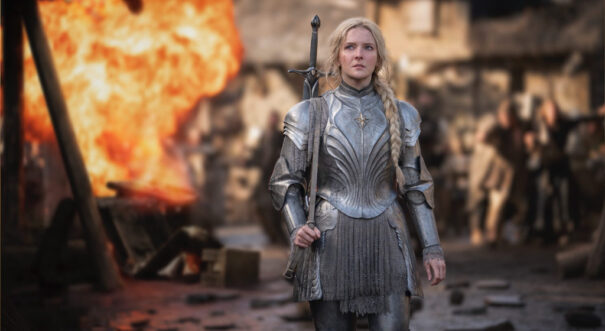‘Lord of the Rings: The Rings of Power’, colorized in the cloud with DaVinci Resolve Studio
Blackmagic Design und Company 3 developed a cloud-based color grading tool, the results of which were implemented in DaVinci Resolve Studio 18, for the color grading of Amazon’s ‘Lord of the Rings: The Rings of Power’ series.
The Rings of Power brings to screens for the very first time the heroic legends of the fabled Second Age of Middle earth’s history. This epic drama is set thousands of years before the events of J.R.R. Tolkien’s The Hobbit and The Lord of the Rings books, and will take viewers back to an era in which great powers were forged, kingdoms rose to glory and fell to ruin, unlikely heroes were tested, hope hung by the finest of threads, and the greatest villain that ever flowed from Tolkien’s pen threatened to cover all the world in darkness.
Shot in New Zealand with visual effects and post production occurring around the world during the pandemic, producer Ron Ames and post production house Company 3 needed an approach to finishing that allowed the various teams to not only collaborate from across continents, but to review in real time. With shot footage totaling 786 hours and 24,659 takes, Ames knew a cloud based solution would be challenging. “That’s a lot of material,” said Ames, who equated the project to the equivalent of four two hour features.
Ames collaborated with Blackmagic Design and Company 3 to create a cloud based color correction solution, the results of which are now included in DaVinci Resolve Studio 18.
“I gave them a year’s notice,” Ames recalled. “I said, ‘I want to color correct this, sitting in New Zealand, with Skip (Kimball) in Los Angeles, or at his home in Idaho.’ We have the same monitors, and in real time, we would color correct. So that’s what we did. It was the most amazing thing!”
The workflow developed, with real time previews and no limitations on any collaborator’s location, with everyone sharing the same media; this is what Ames describes as “a dream come true,” and not something limited to big budgets.
Blackmagic Design worked closely with Company 3’s dedicated engineering team on the development of the tools that would be necessary to accomplish the goal. Company 3’s engineers, who have provided point to point remote services for some time, realized that merely sending graded images from senior colorist Skip Kimball’s DaVinci Resolve Studio workstation to Ames and the others simply wouldn’t accomplish Ames’ requirement.
Instead, the companies worked together to facilitate the creation of what would be essentially a post production studio in the cloud, with color precise HDR monitoring synced live at each location. Based on AWS (Englisch)’s architecture the solution allows media to be manipulated and conformed in the cloud as if everyone were in the same location using local storage to hold the media.
Kimball was involved from the beginning of the project, testing early iterations of the capability. “Almost two years ago in pre production, we built a show LUT that brought film style characteristics to the images, a toe, knee and shoulder,” said Kimball. “That was early in the process and there were still decisions being made about the look of the show, so I made a LUT that didn’t constrain or accentuate any particular colors. We knew I could do that very quickly during the color grade.”
Dynamic workflow
Once production was underway, Kimball was excited about the new cloud based workflow. “We were all working from different locations, across three continents, but with the same media, which was stored in the cloud. I was coloring in Resolve from my home studio in Eagle, Idaho and Ron Ames, associate producer Jake Rice and VFX supervisor Jason Smith were in New Zealand. When I would make a correction on my Resolve system, it would drive a Resolve system where they were, and they could see the changes almost with no latency at all. That was very important to everyone. This was a massive project, and nobody wanted to wait, even a few seconds, to see the changes.”
While the cloud based workflow in DaVinci Resolve Studio 18 allows real time sharing of a Resolve project, in order to share real time video between the systems running DaVinci Resolve Studio, each needs a DeckLink 8K Pro capture and playback card. This allows both sides to monitor 10 bit video in high quality with extremely low latency. During spotting sessions, with Smith, Rice and Ames in New Zealand and Kimball in Los Angeles or Idaho, they could look at raw dailies in real time and discuss where they wanted the look to go in terms of story. “They would talk about how they wanted certain scenes to feel,” Kimball recalled. “Once I had their notes, I would work alone for a while. I’d start playing through it and making corrections by feel. I go very much by instinct.”
Kimball also chose to grade in Dolby Vision. “I made use of the Resolve HDR controls, and everyone collaborating on the color could also see what was happening in HDR on their monitors. That was particularly important for VFX because sometimes an effect works nicely in rec 709 and breaks in HDR.”
With an expansive story and multiple storylines, Kimball had a wide range of looks to play with throughout the season. “The show takes place in different worlds so that played a big part in the grading,” he said. “When we’re with the Harfoots, they wanted it to feel ‘earthy.’ They’re small and close to the grass, so that was part of the look. When we see the Númenoreans’ castle where the king lives, we wanted that to be very lush and vibrant and romantic. There’s a part with a flame set in the Southlands where everything is cold blue and stormy. I was able to isolate the flame in Resolve and turn it from orange to a more golden yellow. The HDR parameters within Resolve are very fine tuned and you can really grab a very specific part of the image to manipulate. We did things like that through the whole season.”
Ames found the new workflow to be a game changer, and not just for huge productions like “The Rings of Power.” He explained, “If you were an independent film, you could use the same systems. You do not have to be a production the size of ‘The Rings of Power’ to benefit from this system. I believe this is modern filmmaking; everybody worked as a singular team. It wasn’t like, ‘Okay, we’re going to finish it and then you’ll get it.’ There was no siloing. I think the process, to me, is as exciting as the result.”
All eight first season episodes of “The Lord of the Rings: The Rings of Power” are now available to stream exclusively on Prime Video in more than 240 countries and territories in multiple languages.
Hat Ihnen dieser Artikel gefallen?
Abonnieren Sie unsere Füttern Und es wird Ihnen an nichts fehlen.
















